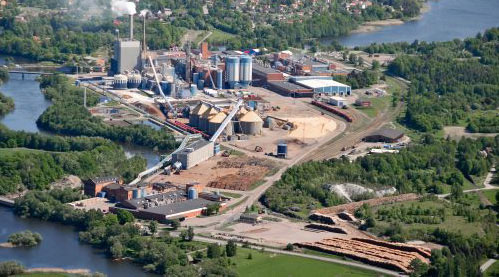| Feb 04, 2014 |
Mill wastewater becomes biogas
|
|
(Nanowerk News) Wastewater from pulp and paper mills contains large volumes of organic material that can be converted into biogas, according to findings by researchers from Water and Environmental Studies (WES) at Linköping University. The pilot trials at the mills are now funded with an additional 14.8 m.
|
|
The researchers from WES have taken samples from 70 wastewater streams at seven mills, and calculated that the potential to extract biogas from the material is at least 70 million normal cubic metres of methane per year. (One normal cubic metre (Nm3) of gas equals one cubic metre of gas at normal air pressure and 0°C.)
|
|
Bo Svensson“We hope to achieve 100 million Nm3, which we probably will when we have fine-tuned the processes. This volume would mean an increased biogas production of roughly 65 per cent, compared to Sweden’s total production for 2012,” says Bo Svensson, professor at WES.
|
|
The research was conducted by Prof Bo Svensson, Dr Annika Björn, Dr Jörgen Ejlertsson and doctoral students at WES, in collaboration with Scandinavian Biogas Fuels AB, Pöyry Sweden AB and several pulp and paper mills.
|
|
The results from the two first years of research are so promising that the Swedish Energy Agency, Linköping University and various industrial partners have reserved SEK 14.8 m over a two-year period, of which the Energy Agency has reserved 8.6 m for the project.
|
 |
| A pulp and paper mill.
|
|
Thus far the tests have been carried out in the lab at WES, where primarily the PhD students Eva-Maria Ekstrand and Madeleine Larsson have taken the samples from the various mills. The results from the two first years of research are so promising that the pilot trials will now be done out at the mills. Today most mills clean their wastewater with oxygen-thirsty aerobic technologies that also consume lots of energy. Two anaerobic, oxygen-free technologies that have proven to work well in the lab will now be scaled up. Both make use of the biogas that forms in the process.
|
|
In brief, both technologies separate the organic material from the flowing water, and try to retain the substrate as well as the microorganisms in the reactor for long enough that methane forms, but with two different technologies.
|
|
Reactors in the laboratoryThe first technology, UASB, (upflow anaerobic sludge blanket), is a type of digestion chamber that is used to clean wastewater, where the water flows into the tank from below. A layer of sludge forms in the middle of the tank. Then small granules or balls form, and their surfaces are covered by methane-forming microorganisms. The water flows upwards through the blanket of granules, the organic material is caught in the lower part and the water is cleaned at the same time as the microorganisms form methane, which bubbles up to the top of the reactor where it is collected.
|
|
“We have tested the technology in the lab. Now we’re going to scale it up from a four-litre reactor to 70 litres, out at a mill. It’s going to be interesting,” says Madeleine Larsson.
|
|
Lab tests are continuing, to find out how well the technology works at different temperatures. One of the leading mills wants to know how the reactor works between 35 C° and 20C°. For this reason, Marielle Karlsson, who also works in the project, has lowered the temperature in one of the reactors to 25C°. So far the microoorganisms are handling it.
|
|
“It happens more slowly at lower temperatures, but the microorganisms can adapt, or else a new population of microorganisms that thrive at low temperatures, that is, psychrophilic, will develop,” says Prof Svensson.
|
|
In the second reactor technology, CSTR (completely stirred tank reactors) with recirculation sludge, substrate digests in a closed chamber, while being stirred, and then is centrifuged into digestion sludge and liquid. Some of the sludge is returned to the reactor, in order to increase the residence time for the microorganisms and to achieve the best possible yield. Thus the fibres and microorganisms are kept longer in the reactor, while the water is allowed to pass through.
|
|
“This technology is well suited to residual products from sulphate pulp processes,” says Dr Björn.
|
|
Tests are also underway to actively recirculate sludge from the mills to the reactors.
|
|
Eva-Maria Ekstrand“The large sedimentation pools store sludge from the mills’ existing aerated purification stage. We want to lower the residence time, in order to increase nutrient content and biodegradability. This enables us to digest the mill sludge together with the fibres, which would reduce the costs of dewatering and aerating the ponds, and boost the yield of biogas,” explains Ms Ekstrand.
|
|
Prof Svensson: “True, more sludge is formed, which the mills don’t actually want, but we want to demonstrate that if we take care of the material earlier, it can be used to form biogas. Also, it means that substances that can be difficult to biodegrade anaerobically can be biodegraded in this step, which means they produce sludge that biodegrades easily.”
|
|
Some innovative solutions have emerged during the course of the project.
|
|
Annika Björn“There are mills that want to use the biogas for dryers, instead of LPG,” says Dr Björn.
|
|
The research has already generated considerable international interest. In particular researchers from Finland have got in touch.
|
|
“We’re one step ahead of the rest of the world – we have extensive knowledge of what is required to ensure that the microorganisms in a reactor develop well,” explains Prof Svensson.
|

